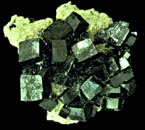|
|
| Formula: | Fe+2Fe2+3O4 |  Click to see a larger image |
||
| Crystal: | Isometric | |||
| Hardness: | 6 | |||
| Spec. Gr.: | 5.2 | |||
| Streak: | Black | |||
| Cleavage: | None | |||
| Location: | Balmat, New York |
| Magnetite is a strongly magnetic ferrous and ferric iron oxide mineral. Because of its distinctive magnetism, magnetite was known to the Chinese as early as the 11th century BC, as well as many natural scientists in Ancient Greece and Rome. It is a widely distributed mineral with crystals being commonly octahedral, and less commonly dodecahedral. Magnetite is an abundant ore of iron, with the largest deposits, believed to be formed by magmatic differentiation, occurring at Kiruna in far northern Sweden. Exceptionally bright and perfect crystals, albeit rather small, are found in the Binnental of Switzerland. Extremely unusual, and possibly unique, was the discovery of perfect, lustrous magnetite cubes up to nearly two cm an edge, at the Zinc Corporation of America's Number Four mine just north of Balmat, in southern St. Lawrence County, New York. The discovery was made in the fall of 1991. Equally unusual was that magnetite crystals formed on a matrix of anhydrite, calcite and halite! The specimen of magnetite in the UCSB Geology Collection is an outstanding example of Cubic magnetite. |
|
Bibliography: Robinson, George, What's New in Minerals. Mineralogical Record, V23, Number 5, pg, 425. |
|
University of California, Santa Barbara—Department of Earth Science Copyright © 2005 Regents of the University of California Send your comments to the Web Page Editor |